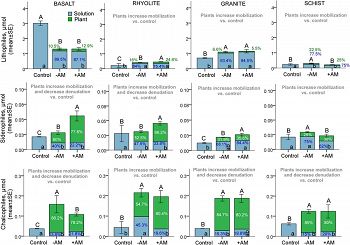Burghelea et al., 2018
Trace element mobilization during incipient bioweathering of four rock types
Burghelea C.I., Dontsova K., Zaharescu D.G., Maier R.M., Huxman T., Amistadi M.K., Hunt E., Chorover J. (2018)
Geochimica et Cosmochimica Acta 234: 98-114
-
Catalina-Jemez, INVESTIGATOR
Abstract
Mass balance of TE fluxes (µmol) released into drainage solution and taken up by plants (µmol) in four rock substrates over 4 months (6 sampling events per column during the experiment). Total denudation and mobilization (denudation loss + plant uptake) significant differences between treatments (ANOVA, P < 0.05, N = 3 replicated columns per treatment) are represented by different capital and lower case letters, respectively. Relative values of denudation loss (%) and plant uptake (%) for the Goldschmidt groups of TE in the planted treatments are also presented.
Lithogenic trace element (TE) patterns of distribution, fate, and behavior in soils are influenced by plants and microorganisms. Our controlled mesocosm experiments quantified how incipient weathering of mineral-bound TEs (Be, V, Sr, Ba, Cr, Co, Ni, Mo, Cu, Zn, As, Se, Ag, Cd, Sn, Sb, Tl, and Pb) varies across four porous mineral substrates (basalt, rhyolite, granite, and schist), in the presence of buffalo grass (Bouteloua dactyloides), associated bacteria, and arbuscular mycorrhizal fungi (AM), a common plant symbiont. Particular focus was given to the net transfer of elements between the solid and solution phases, including chemical denudation (loss of element from the rock to the solution), plant TE uptake, and total mobilization (sum of denudation loss and uptake into plant biomass).
Results revealed differences in TE denudation among rocks, basalt having the highest loss and schist the lowest. TE leaching in solution was time-dependent and it was likely influenced by variations in pH and DOC that were rock- and treatment-specific. The element with the highest rock-normalized release to the solution and highest enrichment in plant biomass was Mo across all rocks. Plants decreased denudation loss compared to abiotic controls for a large number of TEs in all substrates due to plant uptake, but for some elements increase in weathering due to plant activity resulted in increased denudation. Differences in TE patterns of behavior could be related to their Goldschmidt groups. Plant uptake was controlled by TE availability in solution, as well as plant physiological requirements. Plants and associated microbiota significantly enhanced mobilization for the majority of TEs across all rocks.
Mycorrhiza significantly increased above-ground plant biomass production in rhyolite and concentrations in plant tissues for a high number of TEs in basalt. TE uptake into biomass was positively correlated with percent mycorrhizal infection, particularly in basalt and rhyolite. Mycorrhizal fungi also influenced TE denudation, rock-water fractionation, and total mobilization according to the rock type. Mycorrhizal activity was associated with a significant decrease in pH and increase in DOC fluxes in schist, supporting the idea that fungi enhance production of root exudates especially in substrates that are difficult to weather.
Our results highlight the importance of incipient weathering at the plant-rock interface for patterns of TE cycling. They also indicate the importance of mycorrhiza in mineral dissolution, TE denudation, plant element uptake, and biomass growth.
Citation
Burghelea C.I., Dontsova K., Zaharescu D.G., Maier R.M., Huxman T., Amistadi M.K., Hunt E., Chorover J. (2018): Trace element mobilization during incipient bioweathering of four rock types. Geochimica et Cosmochimica Acta 234: 98-114. DOI: 10.1016/j.gca.2018.05.011
 This Paper/Book acknowledges NSF CZO grant support.
This Paper/Book acknowledges NSF CZO grant support.
Explore Further


